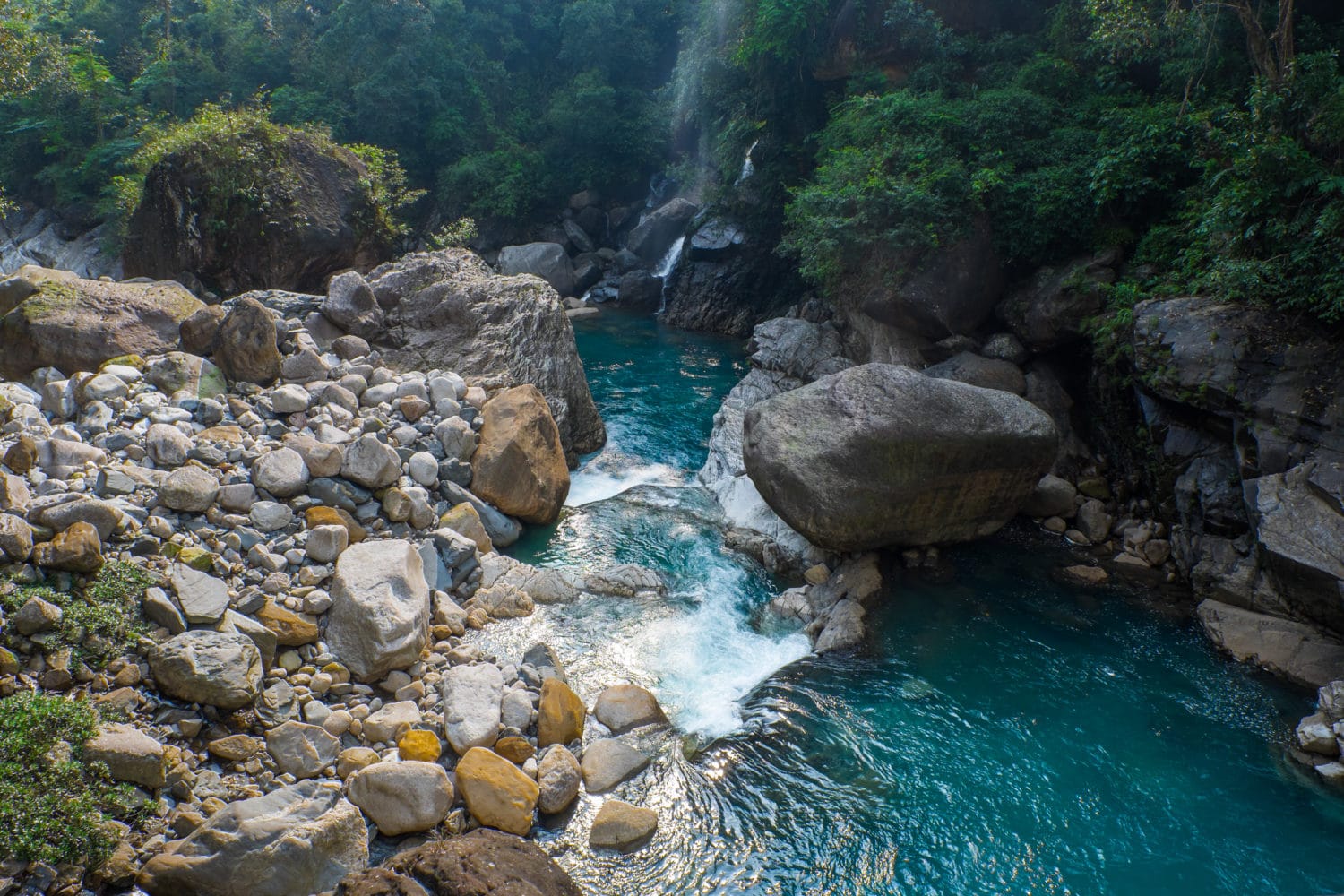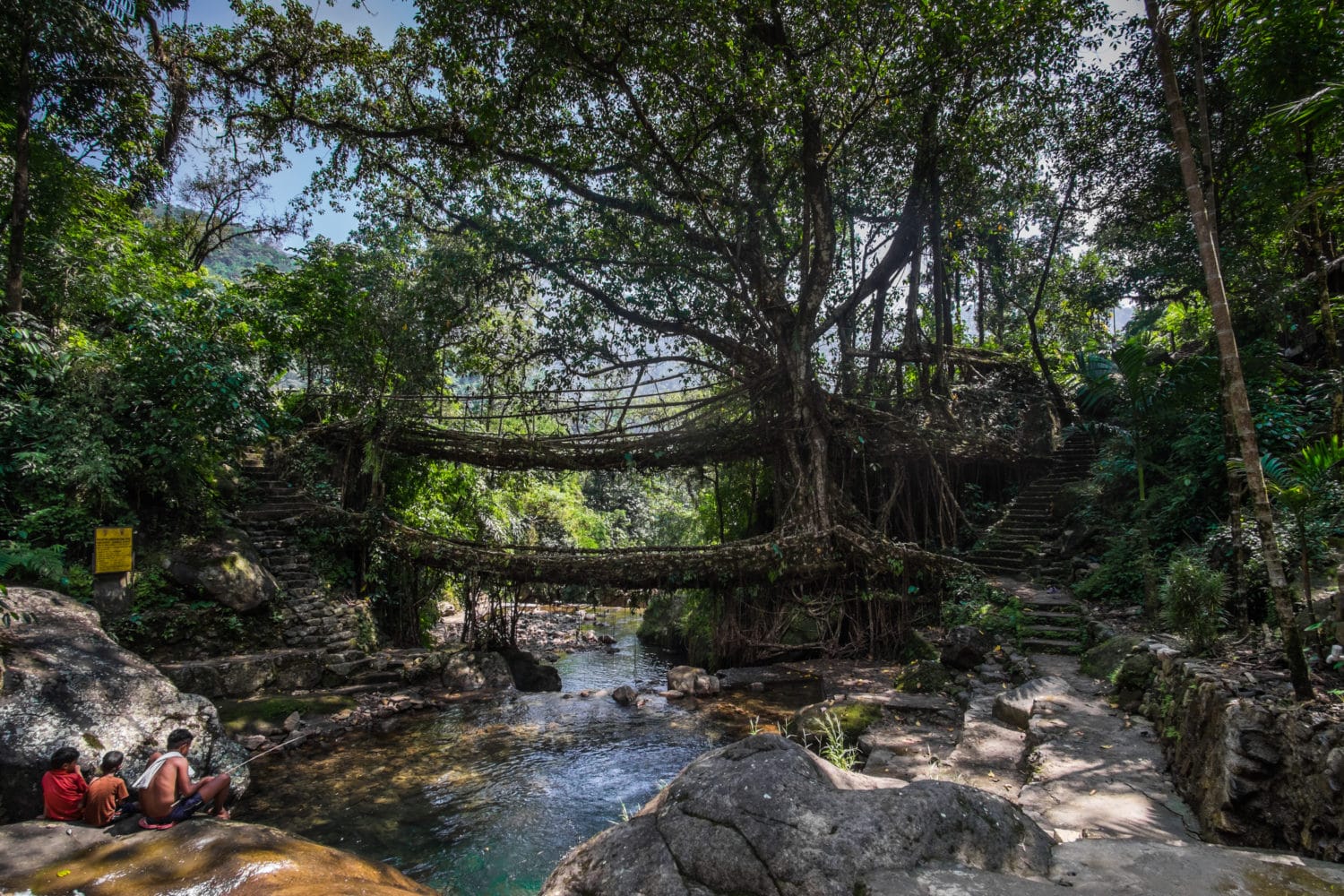Meghalaya, a state in the North East of India, bordering Bangladesh, is one of the most stunningly beautiful places in India. Living up to its name, which means “Abode of Clouds” Meghalaya is home to the Cherrapunji region, famous for being the wettest place on earth (the average rainfall is 11,777mm), and sustains a unique and dense rainforest ecosystem. Amongst the wonders of Cherrapunji (and there are many) are the incredible structures known as living root bridges. Built over 15-20 years, the bridges are literally as the name suggests, made of roots and living and the earliest ones have existed for over a hundred years, helping the local tribes cross fast flowing rivers and deep gorges. The most amazing all of the bridges is the double decker one, located in Nongriat Village, deep down the hills of Cherrapunji.

About a hundred years ago the Khasi elders living in Sohra (the local name for Cherrapunji) devised an ingenious method to cross the rivers in the hills where they had been living for generations. The Cherrapunji plateau is the wettest place on earth, green and lush, and in the monsoon time, it is impossible to cross the rivers that are the lifeline of the local tribes and villagers living in the hills.
War Khasis (war is slope in the Khasi language, so they are tribes who live on slopes of hills) manipulated the roots of the rubber tree to grow over mountain streams. Using pieces of betel nut trunks as support in the beginning, the roots, over time, were intertwined with roots of trees on the opposite bank. The roots catch on the other side and grow into a thick sturdy mass. This whole process takes about 15-20 years, but in the end, there is a bridge, living and growing, that can hold the weight of several people at once. Secondary roots are then fashioned into support structures as well as to create railings to hold onto while crossing. It is a surreal experience knowing that you are walking on the roots of living trees to cross a river or chasm.
Cool Cultural Facts
The Khasi tribes follow a matrilineal society, and families can be traced back through the surname of the wife. The youngest daughter inherits all the property. The Khasi’s are extremely friendly and welcoming and have a huge amount of community spirit. Many families have been living in these hills and gorges and plains for generations and it is important to keep this in mind when travelling and interacting with them.

How to get to the bridges
The living root bridges can be seen in two places – 1. In Riwai village adjoining the tourist hotspot of Mawlynnong, marketed as the cleanest village in Asia. The bridge is a short 10 minute walk from the village and is easy access for all, and this crawling with tourists. If you don’t mind a little walking, we suggest option 2. Nongriat.
Nongriat is the village deep down on the slopes of the East Khasi hills. To get here, you first fly or take a train into Guwahati Airport. Guwahati is the capital of Assam in North East India, and is accessible by flights from all major cities in India. From the station or the airport, take a shared taxi either all the way to Tyrna Village, or upto Shillong (the capital of Meghalaya) and then hop onto a bus to Tyrna. Sometimes there might not be a direct bus to Tyrna, so you might have to change buses at some point. If possible take the taxi all the way, even if it costs a little extra. A seat on a shared taxi (usually a 10 seater jeep) will cost about Rs.250-300.
Once you get to Tyrna Village you will see the ‘Bro’s ‘n’ Two Sis’s Shop, a basic little tea stall good for a warm cup of tea and some hot noodles. It is from here that the real journey begins. The first climb is about 2,000 odd steps till you reach Nongthymmai village. There is one bridge at this village, which most people see and leave. But if you want to see the double decker bridge, you have to keep going.
At Nongthymmai, you take the left path and walk another 1,000 odd steps till you reach two suspension bridges, cross over, climb half way up another hill till you see the sign for Nongriat and the Double Decker Bridges.
There is a clear cool pool of water created by rocks where you can rest and gather you senses. The water helps sooth the muscles. The entire journey is not for the faint hearted, and people with knee and back problems, pregnant women, and those with heart issues are advised against this.

When to go
There is no bad time to go, though it is best to avoid the monsoon season from May to October, as the heavy rains make walking up and down the hills much harder.
Where to stay
There are two main options, and this depends on the kind of holiday or visit you are planning.
One option, which we recommend, is to stay at the very basic but picturesque Serene Guest House in Nongriat (Ph No: +961 5252 655 / +943 6739 655 / Email: byronnongbri@gmail.com) . The guest house is extremely cheap (Rs. 300 for one as of September 2015), but has the perfect location, overlooking the bridges and the gushing river. After walking down over 3,000 steps, it is a great place to spend a couple of days and avoid walking up the same day.
However, if time is not a factor, then we suggest the Cherrapunji Holiday Resort, a lovely family run resort, about 10km from Tyrna Village. The resort was started by a local couple, a Khasi woman and her Tamilian husband. They are extremely helpful and full of interesting stories of the region and its culture. The food at the resort is a mix of local and regular India fare. From the resort you can hire a car and guide, and visit other places in the area as well.
What else can you do?
Cherrapunji is far, unless you are coming from Bangladesh, which it shares a border with, or other parts of the North East. Shillong is a great place to spend a couple of days, and is most famous for its music cafes and old British charm. The lake is dotted with pretty resorts, where you can spend time relaxing or trying different water sports.
Meghalaya itself has several other tourist attractions:
~ Several waterfalls, caves and trekking options in Cherrapunji
~Mawlynnong the cleanest village in Asia
~Dawki Lake at the border of India and Bangladesh, a beautiful clear lake surrounded by lush greenery If you are so inclined, you could combine a trip to Meghalaya with other states in the North East, or plan your travel around one of the many music festivals of the region. Some of these are the Ziro Festival in Arunachal held in late September; the Shillong Autumn Festival in November; or the Hornbill Festival in Nagaland, usually held in December.

This post first appeared on the Gamin Traveler
Wonderful to come across your podcast today on IVM podcasts. Is the end of November a good time to travel to Meghalaya?
It’s a good time Shivkumar, but do bear in mind that most of the waterfalls would have started thinning by then.
And glad to know you are enjoying our podcast!
Wow! This is incredible! It’s amazing when you think of the ingenuity it took to create the bridges in the first place. It looks absolutely beautiful and your trip must have been wonderful!
It really was quite amazing what they achieved all the way deep in that gorge. So clever but so in tune with nature. It’s a great place.
SO beautiful!!!!
Shillong has an annual Bob Dylan festival to celebrate his birthday!
On Tuesday, July 19, 2016, The reDiscovery Project wrote:
> therediscoveryproject posted: “Meghalaya, a state in the North East of > India, bordering Bangladesh, is one of the most stunningly beautiful places > in India. Living up to its name, which means “Abode of Clouds” Meghalaya is > home to the Cherrapunji region, famous for being the wettest pl” >